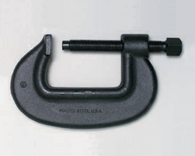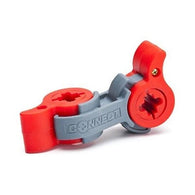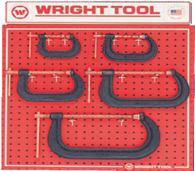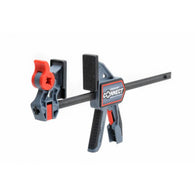Workholding & Positioning
Workholding Solutions:
Whether you are milling on a CNC machine or simply bonding two pieces of wood, you will need a tool to help hold the work piece in a solid position. Workholding solutions tackle this issue by offering a variety of tools that help to hold parts in place, clamp parts or provide indexing for precision work. This may include everything from c-clamps, vises or precision indexing slide tables.
Industrial Tool Supply offers a wide selection of work holding clamps and solutions. We have handpicked our vendors from our years of manufacturing experience. We chose brands that offer quality construction, dependable performance, and a reasonable price point.
Types of C-clamps and what to look for:
C-clamps are designed to hold the material in place by inserting the workpiece into the jaws of the clamp and then turning a threaded screw to tighten the pieces inside the jaw. Friction and pressure hold the pieces in place. Going beyond the basics, the different types of c-clamps are purpose built so that the different sizes and shapes of workpieces can be held securely.
C-clamps tend to fall into 3 category types:
- Regular Duty: for projects that do not require large holding forces.
- Heavy Duty: these may include professional work in wood or metal fabrication
- Super Duty: this includes commercial and industrial applications requiring tremendous clamping pressure.
Cantilever Clamps: These types of clamps offer several advantages over standard c-clamps. They are lighter, stronger and won't walk-off-center when being tightened. Cantilever clamps are a good choice for spot welding, drilling, bolting work pieces together or whenever you need to hold two pieces firmly in place.
Deep Throat C-Clamps: These are designed to provide enough space for larger or bulkier pieces to be held in place by having extra space in the opening of the clamp. Many deep throat clamps feature specific opening shapes or sizes and have different materials or coatings used for the tightening spindles including black oxide and copper.
Vises: One of the most important tools in your shop should be a vise. You need a strong durable tool to hold parts securely while you work on them. Vises have two parallel jaws that, when squeezed together using a threaded spindle, hold the workpiece in place. Vises are commonly used in metalworking, woodworking, electronics, and model-making. Basically, anywhere you need to keep your hands at a safe distance away from the workpiece, or when you need both hands to work on it.
Choosing the Right Vise:
Before you buy a vise, you should take into consideration what it will primarily be used for or what type of work will you be doing? There are specific vises made for wood workers, welders, and machinists, all containing specific features to that application. For around the house type work, a simple 4 or 5-inch vise will be sufficient but a much larger and heavy duty unit may be required for manufacturing or industrial work.
Be aware of the throat depth, the measurement from the top of the jaws to the top of the slide below it. Longer throat depth means you can hold larger pieces more securely. How wide a vise opens can also be a limiting factor. Another factor to look at is how heavy and durable the unit is, remember a vise needs to hold a workpiece in place so heavier duty is usually better when choosing vises.
The most common type of vise is a bench vise and it is used by machinists and metal workers in a wide range of applications. The bench vise offers many styles or features depending on the type of work you will be performing. Below are some examples of vises we have available.
Angle Vises: An angle vise, also called a tilting vise, is a vise that can be tilted to set a clamped workpiece up at an angle for machining or milling.
Drill Press Vise: These are vises that have been designed to work in conjunction with a drill press as they offer higher accuracy for drilling procedures. They commonly include general, traditional and precision ground drill press vises.
Self-Centering Vises: A self-centering vise means that both jaws move towards the center as the screw is turned. Much like a two-jaw chuck, it provides accuracy and helps reduce set up time especially on repeatable operations.
Slide Tables: A slide table is designed for applications requiring closely held parallelism and perpendicular specifications. The table and bearing guide are integrated into one precisely machined part minimizing tolerance stack-up associated with multiple part assemblies. A slide table is a work holding vise with tremendous accuracy.
Dividing Plates: These are used in conjunction with rotary tables in machining. Dividing plates allow you to precisely divide a circle into many divisions or degrees. The indexing feature helps prevent errors during the repetitive adjustments required in indexing work. Dividing plates can be used to create bolt circles, gears, polygons, and more.
Indexing Tables: These allow work pieces to be rotated at an angle or even be divided into sections. They control the accuracy of the fit and hold the piece in place with ease. A rotary table can tilt and rotate. The table makes use of the indexing head in order to cut according to a specific technique.




